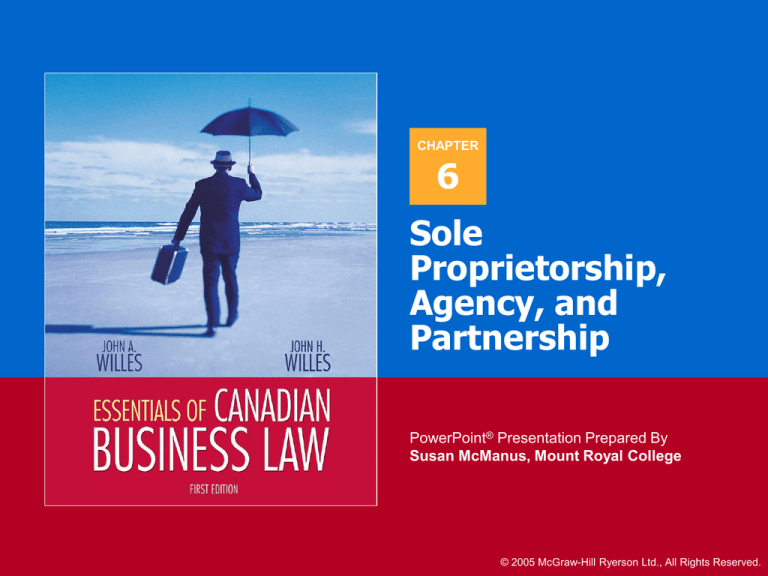
CHAPTER
6
Sole
Proprietorship,
Agency, and
Partnership
PowerPoint® Presentation Prepared By
Susan McManus, Mount Royal College
© 2005 McGraw-Hill Ryerson Ltd., All Rights Reserved.
CH 6
LEARNING OBJECTIVES
Consider legal environments of business
organizations
Examine forms of business organizations
Outline areas of law applicable to sole
proprietorships
Examine the law related to agency relationship
Examine the law of partnership
Essentials of Canadian Business Law, 1st Canadian Edition
Slide 6-1
© 2005 McGraw-Hill Ryerson Ltd., All Rights Reserved.
6.1
Forms of Business Organization
Business Organizations
Legal relationships that carry on business
Requirements due to concern for public safety and
protection
Legislation governs the formation and operation of
the business organizations, and the law of contract
applies to the conduct of business activities
Types of business organizations:
Sole proprietorship
Agency
Partnership
Corporation
Essentials of Canadian Business Law, 1st Canadian Edition
Slide 6-2
© 2005 McGraw-Hill Ryerson Ltd., All Rights Reserved.
6.2
Sole Proprietorship
“one-owner business”
Sole proprietor:
Owns all assets
Carries on business
activities
Entitled to all profits
Responsible for all debts
Laws:
Licensing and registration
Operation of business based on contract law
Who would be a sole proprietor?
Essentials of Canadian Business Law, 1st Canadian Edition
Slide 6-3
© 2005 McGraw-Hill Ryerson Ltd., All Rights Reserved.
Figure 6-1
Agency—
Contractual
Relationships
Essentials of Canadian Business Law, 1st Canadian Edition
Slide 1-4
© 2005 McGraw-Hill Ryerson Ltd., All Rights Reserved.
6.3
The Agency Relationship
Agency
A person or business acts on behalf of another
person or business
Parties in Agency
Principal hires an agent to carry out business dealings
with a third party, usually to allow the principal to enter
a contract with the third party
Relationship may be based upon
Contract – verbal or written with set terms
Agency by conduct or agency by estoppel – by words
or actions agency is created
Essentials of Canadian Business Law, 1st Canadian Edition
Slide 6-5
© 2005 McGraw-Hill Ryerson Ltd., All Rights Reserved.
6.3
The Agency Relationship (Cont’d)
Duties &
Responsibilities of the
Parties
Agency is based upon
utmost good faith relationship is of special
trust and confidence
Essentials of Canadian Business Law, 1st Canadian Edition
Slide 6-6
© 2005 McGraw-Hill Ryerson Ltd., All Rights Reserved.
6.3
The Agency Relationship (Cont’d)
Principal’s Duties:
Pay the fixed fee or a reasonable fee for services
rendered
Compensate for any reasonable expenses in carrying
out the services
Essentials of Canadian Business Law, 1st Canadian Edition
Slide 6-7
© 2005 McGraw-Hill Ryerson Ltd., All Rights Reserved.
6.3
The Agency Relationship (Cont’d)
Agent’s Duties:
1. Obey all lawful instructions and keep information
confidential
2. Inform the principal and be in constant contact
(notice to an agent is notice to the principal)
3. Maintain the standard of skill required with no
delegation unless permission is granted
4. Account for goods or money
5. Place the best interest of the principal first
6. Do not act for both the principal and third party
without express consent
Essentials of Canadian Business Law, 1st Canadian Edition
Slide 6-8
© 2005 McGraw-Hill Ryerson Ltd., All Rights Reserved.
6.3
The Agency Relationship (Cont’d)
Agency by Conduct or Estoppel
Principal by words or conduct leads the third party
to believe the agent has authority (apparent
authority)
Principal will be bound by the agent’s actions
Created by:
Adoption of a contract negotiated by another
No notification of agency termination
No notification of restrictions on the agent’s authority
(agent then exceeds the actual authority)
Essentials of Canadian Business Law, 1st Canadian Edition
Slide 6-9
© 2005 McGraw-Hill Ryerson Ltd., All Rights Reserved.
6.3
The Agency Relationship (Cont’d)
Agency by Operation of Law
Agency of necessity – agent acts in an emergency
to prevent a loss; a pre-existing legal relationship
exists
Ratification of Contracts by a Principal
Acceptance of contract made by an agent who
exceeds authority or has no authority
Essentials of Canadian Business Law, 1st Canadian Edition
Slide 6-10
© 2005 McGraw-Hill Ryerson Ltd., All Rights Reserved.
6.3
The Agency Relationship (Cont’d)
Third Parties and the Agency Relationship
Agency is clearly stated
only the principal is liable to the third party
Agent contracts without disclosing the agency
the agent will be liable to the third party
Agent contracts on behalf of an undisclosed principal
the third party may hold either the agent or the principal
liable (not both)
Agent contracts with no authority or on behalf of a
nonexistent principal
the agent will be liable for breach of warranty of authority
Essentials of Canadian Business Law, 1st Canadian Edition
Slide 6-11
© 2005 McGraw-Hill Ryerson Ltd., All Rights Reserved.
6.3
The Agency Relationship (Cont’d)
Liability of Principal & Agent to Third Parties in
Tort
Vicarious liability – principal may be liable for torts
committed by the agent in the course of the agency
agreement
Termination of the Principal–Agent Relationship
1. Notice – principal should notify third parties or the
principal may be liable by apparent authority
2. Completion of task or service
3. Incapacity of either party
4. Bankruptcy of the principal
Essentials of Canadian Business Law, 1st Canadian Edition
Slide 6-12
© 2005 McGraw-Hill Ryerson Ltd., All Rights Reserved.
6.4
The Law of Partnership
Partnership
A legal relationship between two or more persons for the
purpose of carrying on a business with a view of profit
Formed and governed by:
Legislation – Partnership Act
Conduct - a third party believes a person through his or her
words or conduct is a partner
Nature of a Partnership
Sharing of profits
Contribution of capital
Active participation in management
Unlimited liability for losses by the partnership
Essentials of Canadian Business Law, 1st Canadian Edition
Slide 6-13
© 2005 McGraw-Hill Ryerson Ltd., All Rights Reserved.
Figure 6-3
Liability of
Partnership to
Third Parties
Essentials of Canadian Business Law, 1st Canadian Edition
Slide 1-14
© 2005 McGraw-Hill Ryerson Ltd., All Rights Reserved.
6.4
The Law of Partnership (Cont’d)
Liability of a Partnership or Firm for the
Acts of a Partner
Every partner is the agent of the firm in the
ordinary course of partnership business
Firm is liable for torts, and careless and improper
acts committed by the partner in the ordinary
course of partnership business
Partners have unlimited liability (jointly and
severally) for losses by the firm, and may therefore
be liable for the actions of other partners
Essentials of Canadian Business Law, 1st Canadian Edition
Slide 6-15
© 2005 McGraw-Hill Ryerson Ltd., All Rights Reserved.
6.4
The Law of Partnership (Cont’d)
Rights and Duties of Partners to One
Another
Usually set out in a partnership agreement, if not
defined by the Partnership Act
Partnership property brought into or acquired by
the partnership and is held and used for the
benefit of the partnership
Partnership is based on utmost good faith as
partners must perform in the best interests of the
partnership as a whole (accounting of money and
information, and not to compete with the
partnership)
Essentials of Canadian Business Law, 1st Canadian Edition
Slide 6-16
© 2005 McGraw-Hill Ryerson Ltd., All Rights Reserved.
6.4
The Law of Partnership (Cont’d)
Dissolution of a Partnership
Notice to dissolve, usually a term of the
agreement, may include
Disposition of the firm name
Method of determining value of business assets and
partners’ shares
Upon completion of specific term or task
Incapacity or death of a partner
Unlawful purpose of the partnership
Essentials of Canadian Business Law, 1st Canadian Edition
Slide 6-17
© 2005 McGraw-Hill Ryerson Ltd., All Rights Reserved.
6.4
The Law of Partnership (Cont’d)
Dissolution of a Partnership
Court order:
Circumstances that are “just and equitable”
Once dissolved firm’s assets are liquidated and the partners’
shares determined
Firm’s debts must be paid first:
if a deficit occurs partners contribute in proportion to share
of profits entitlement
if there is a bankruptcy then contribution is by the ratio of
capital account
NOTICE – should be given to all customers and the public at
large (provincial Gazette) to prevent further liability
Essentials of Canadian Business Law, 1st Canadian Edition
Slide 6-18
© 2005 McGraw-Hill Ryerson Ltd., All Rights Reserved.
Figure 3-3
Basic Characteristics and Differences between
a Sole Proprietorship and a Partnership
Essentials of Canadian Business Law, 1st Canadian Edition
Slide 1-19
© 2005 McGraw-Hill Ryerson Ltd., All Rights Reserved.
6.5
Limited Partnership
Limited Partnership: set by legislation
Limited partners: limited liability; limited to capital
contributed
Limited partners: no active participation in the firm,
if they participate they become general partners
with unlimited liability
Limited Liability Partnerships
Partners have unlimited liability for the firm debt
and their own negligence, but no responsibility for
the negligence or omissions of other partners
(usually professional practices)
Essentials of Canadian Business Law, 1st Canadian Edition
Slide 6-20
© 2005 McGraw-Hill Ryerson Ltd., All Rights Reserved.
6.7
Registration of Partnerships
To provide creditors and others with information
concerning the business and persons who own it
Declarations of basic partnership information must
be filed at a government office
Changes usually must be filed
Essentials of Canadian Business Law, 1st Canadian Edition
Slide 6-21
© 2005 McGraw-Hill Ryerson Ltd., All Rights Reserved.
6.8
Joint Ventures
Two or more businesses contract to undertake a
specific project
May create a separate corporation or be governed
by contract
Based on utmost good faith
Essentials of Canadian Business Law, 1st Canadian Edition
Slide 6-22
© 2005 McGraw-Hill Ryerson Ltd., All Rights Reserved.
CH 6
SUMMARY
Sole Proprietorship
“One-owner” with unlimited liability
Agency
Principal obtains the services of an agent to negotiate a
contract with a third party
Based on utmost good faith
Partnership
Two or more persons carrying out business for profit
Based on utmost good faith, and partners are agents for the
firm
Unlimited liability unless Limited Partnership or LLP
Essentials of Canadian Business Law, 1st Canadian Edition
Slide 6-23
© 2005 McGraw-Hill Ryerson Ltd., All Rights Reserved.







